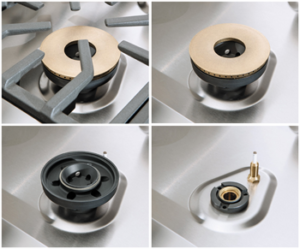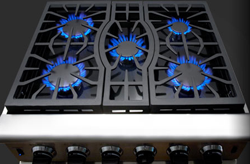When shopping for the best commercial-style range or rangetop for your home, one of the major decisions is choosing sealed vs open burners. It’s a debate in which some chefs are quite passionate, and there are extensive cooking forum discussions on this subject that offer valuable user opinions. However, while there are distinct differences, there is no clear front-runner in the open vs sealed burners debate. It generally comes down to cooking style and personal preference, as we’ll attempt to explain here.
 Open burners are the traditional commercial design, and feature a circular vent around the burner components. Spills can fall into the flame and down inside the range itself. However, a drip tray catches these spills, and all burner parts can be removed for thorough cleaning. The cleaning process may be slightly more laborious, but many cooking enthusiasts favor open burners for several reasons. Among professional chefs, open burners are the clear choice. In fact, commercial kitchens generally rely exclusively on open burners. For some, the fact that open burners offer a more professional style is enough to form a decision.Sealed burners are the most common type seen in residential kitchens. Most agree they are easier to clean because the seal between the burner and the surrounding frame keeps spills contained. A one-piece cooking surface extending around all burners, so messes cannot escape beyond your reach. Simply remove the grates and burner caps and wipe down the surface below.
Open burners are the traditional commercial design, and feature a circular vent around the burner components. Spills can fall into the flame and down inside the range itself. However, a drip tray catches these spills, and all burner parts can be removed for thorough cleaning. The cleaning process may be slightly more laborious, but many cooking enthusiasts favor open burners for several reasons. Among professional chefs, open burners are the clear choice. In fact, commercial kitchens generally rely exclusively on open burners. For some, the fact that open burners offer a more professional style is enough to form a decision.Sealed burners are the most common type seen in residential kitchens. Most agree they are easier to clean because the seal between the burner and the surrounding frame keeps spills contained. A one-piece cooking surface extending around all burners, so messes cannot escape beyond your reach. Simply remove the grates and burner caps and wipe down the surface below.
However, there is more to know. Open burners offer more direct heating in which the open flame comes up from the center of the burner and heats the pan with a more focused flame direction. The burning fuel of an open burner also comes into more contact with oxygen in the air due to the surrounding vent, which increases heat output and efficiency. Many argue that this increased airflow also allows for lower simmer settings.
In contrast, the flame on a sealed burner must draw oxygen from the gaps between the cooking surface and the cooking vessel, resulting in less heat. In addition, due to the wide caps typical on sealed burners, some of the heating efficiency is lost as the flame spreads out across the bottom of the pot. The output is less focused than that of an open burner, whose flame is pointed directly at the center of the cooking vessel.
 Sealed vs. Open Burners: Efficiency Matters
Sealed vs. Open Burners: Efficiency Matters
The open burner is arguably more efficient, and several videos are available online demonstrating this fact. In one example, identical pots containing the same amount of water were set on open and sealed burners, and each burner was turned on high. The unsealed burner brought water to a higher temperature quicker and induced a rolling boil long before the sealed burner could.
Some of this difference may be mitigated by the fact that many brands offer higher BTU ratings on their sealed burners. For example, FiveStar open burners have up to 14,000 BTUs, while their sealed burners offer up to 21,000 BTUs (One BTU heats one pound of water by about 1°F). But BTU ratings refer to fuel input rather than heat output, so BTU ratings may not give the clearest picture of which burner type is more powerful.
When comparing sealed vs unsealed burners, it is also important to note that unsealed burners are only available on ranges and rangetops. Gas cooktops exclusively feature sealed burners. Also, when comparing sealed vs non-sealed burners on similar models, non-sealed burners are typically the less expensive option. Armed with this insight on Sealed vs. Open Burners, move your appliance search along today at Elite Appliance.


 Sealed vs. Open Burners: Efficiency Matters
Sealed vs. Open Burners: Efficiency Matters

